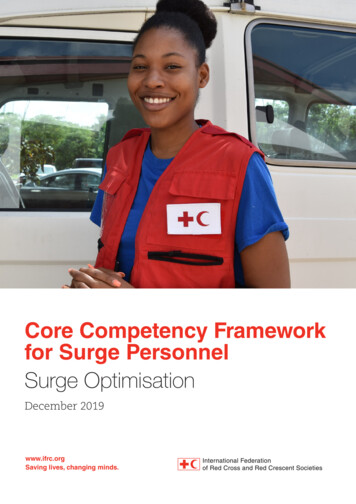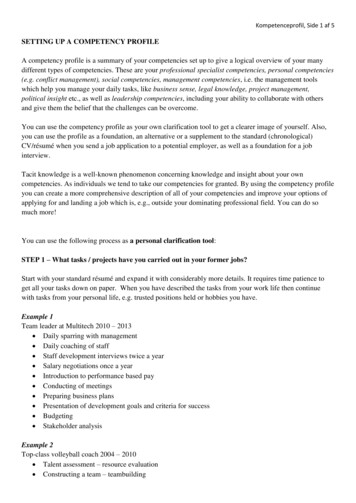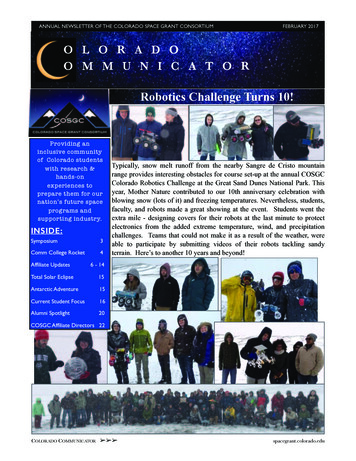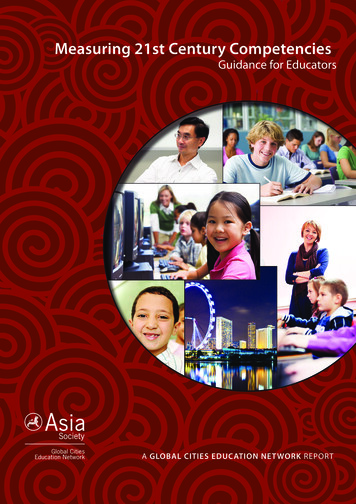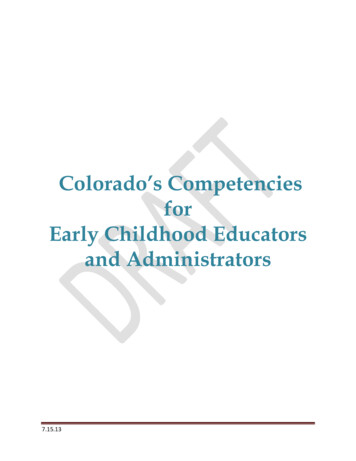
Transcription
Colorado’s CompetenciesforEarly Childhood Educatorsand Administrators7.15.13
Colorado’s Competencies forEarly Childhood Educators and AdministratorsACKNOWLEDGEMENTSColorado’s Early Childhood Leadership Commission’s Program Quality, Coordination,and Alignment Committee requested that Colorado’s Early Childhood ProfessionalDevelopment Advisory Group develop a framework of competencies with outsideconsultants, Oldham Innovative Research, contracted by the Lieutenant GovernorGarcia’s Office. Feedback and input was also provided by stakeholders throughout theState of Colorado along with national experts.Individuals that the Professional Development Advisory Group would like to thank fortheir input include: Alison Lutton and Billie Young of National Association of YoungChildren (NAEYC)Anne Mitchell of Early Childhood Policy Research and the Alliancefor Early Childhood Finance, Camille Catlett of the Frank Porter Graham ChildDevelopment Institute, Mari Blaustein of Early Childhood Initiatives: the Source forLearning, Inc., Phil Baimas of the Massachusetts Department of Early Education andCare, Shelly Nye of the Nevada Registry, Thomas Schultz of the Council of Chief StateSchool Officers, Donna Ruhland of Ohio’s Child Care Resource and ReferralAssociation, Holly Higgins Wilcher of Zero to Three, Virginia Maloney of the ChambersFamily Fund, Kathleen DeVries of Red Rocks Community College, Tara BoertzelSchuenemann and Jean Williams of CDE’s Educator Effectiveness Unit, Malinda Jonesof Metropolitan State University of Denver, Sudy Opsahl, Jennifer O’Brien and KatrinaBoykin of Colorado Department of Education’s (CDE) Early Childhood ProfessionalDevelopment Team, Cerissa Stevenson of Colorado State University, Janet Humphryesco-author of Guiding Children’s Potentials: Heartened Parenting, Coaching Journal, teammembers from the Comprehensive Training Opportunities for Paraprofessionals inEarly Intervention Services Coalition, Heather Tritten and others from QualistarColorado, Jordana Ash, Mental Health Partners, Karen Barrett of Colorado StateUniversity, Olivia Coyne of Boulder County Head Start, Bertha Campbell, ColoradoEarly Childhood Advocate, Nicole Simpkins of Bright Horizons, Deborah Covill ofFamily Star Head Start, Donna Brady-Lawler of Northeastern Junior College, JaniceKneppe of Red Rocks Community College, Dr. Douglas Clements of The MarsicoInstitute of Early Learning and Literacy Nancie Linville of Clayton Early Learning, Dr.Pamela Harris of Mile High Montessori Early Learning Centers, Phyllis Dornseif ofLittleton Public Schools and Marie Hueston of Family Flex Early Education Center.7.15.13
Many other state frameworks that were available via state websites were examined tohelp in this work. States that were looked at included: Maine, Massachusetts, RhodeIsland, Nevada, Ohio, Washington, Virginia, Arkansas, and California.FUNDINGFunding for the creation of the State of Colorado Competencies for Early ChildhoodEducators and Directors came from the Colorado Early Childhood LeadershipCommission and the American Recovery and Reinvestment Act of 2009.Members of the Early Childhood Professional Development AdvisoryGroup: Competencies Sub-CommitteeProfessional Development AdvisoryGroup: Competencies Sub-CommitteeMembersAmanda MorenoBarbara SawyerBecky KeiganBrittany LaneEmmy GlancyDorothy ShaplandGinger MaloneyHeather SporrerHeather TrittenJanet HumphryesKatrina BoykinJean WilliamsJennifer O’BrienJordana AshKaren BarrettKathleen DeVriesKathleen StilesKathryn HammerbeckKaty AnthesLinda Adams7.15.13AffiliationUniversity of DenverNational Association for Family ChildcareProvidersColorado Extension Office at ColoradoState UniversityDepartment of Higher EducationDepartment of Higher EducationBuell Early Childhood Leadership FellowChambers Family FundColorado Department of Human ServicesQualistarHead StartColorado Department of EducationEducator Effectiveness at ColoradoDepartment of EducationColorado Department of EducationMental Health ConsultantColorado State UniversityRed Rocks Community CollegeConsultantColorado Early Childhood EducationAssociationEducator Effectiveness at ColoradoDepartment of EducationColorado Association for the Education of
Linda ForrestMarie HuestonNancie LinvillePamela HarrisPhyllis DornseifRobin Levy-ContiSondra RanumSudy OpsahlTara Boertzel-Schuenemann7.15.13Young ChildrenUniversity of Northern ColoradoFamily Flex Child CareClayton Early LearningMile High Montessori Early LearningCentersThe Village at Littleton Public SchoolsThe Pyramid Plus Center, University ofColorado Denver; Buell Early ChildhoodLeadership FellowColorado Department of EducationColorado Department of EducationEducator Effectiveness at ColoradoDepartment of Education
Table of ContentsCore Competencies Overview .CORE COMPETENCY DOMAIN: Child Growth, Development, andLearning .Knowledge of Developmental Domains, Changes, and Milestones .How Children Learn and Approaches to Learning Individual Needs and Differences Identified Special Needs .Fostering Healthy Attachment and Relationships .CORE COMPETENCY DOMAIN: Child Observation andAssessment.Principles .Gathering and Documenting .Summarizing and Interpreting .Sharing and Reporting .CORE COMPETENCY DOMAIN: Family and Community Partnerships.Valuing Families .Respect for Diversity Effective Communication .Building Reciprocal Relationships with Families .Resources that Support Children and Families .CORE COMPETENCY DOMAIN: Guidance .Positive Interactions and Relationships with Individual Children .Child Guidance: Discipline .Communication .Guidance: The Role of Staff and Other Adults .Enhancing Group Experiences .CORE COMPETENCY DOMAIN: Health, Safety, and Nutrition .Knowledge of Regulations .Health .Safety .Nutrition .7.15.13
CORE COMPETENCY DOMAIN: Professional Development andLeadership Ethics and Codes of Conduct .Reflective and Continuous Professional Development .Advocacy .CORE COMPETENCY DOMAIN: Program Planning andDevelopment .Program Planning and Evaluation .Personnel Management .Resource Management .CORE COMPETENCY DOMAIN: Teaching Practice .Planning Framework for Curricula and Learning Environment .Physical Health Promotion .Language and Literacy Promotion .Cognitive Development Promotion .Social-Emotional Development Promotion .Fostering Creativity .Transitions .GlossaryReferencesAppendixAlignment with other Colorado Initiatives .7.15.13
Competencies for Early Childhood Educators andAdministrators: An OverviewHistory of the Competencies for Early Childhood Educators and AdministratorsColorado’s Early Childhood Leadership Commission adopted Colorado’s EarlyLearning Professional Development System Plan created through the LieutenantGovernor’s Office with support from the Early Childhood Professional DevelopmentAdvisory Group. A key priority within the plan was to develop a framework ofperformance-based competencies for early childhood educators and administrators. ARequest for Proposals was announced, and Oldham Innovative Research was awardedthe contract to work collaboratively with the Professional Development AdvisoryGroup’s Competencies Sub-Committee. The ECLC’s Program Quality, Coordinationand Alignment Committee oversaw the process. Through many iterations of gainingfeedback from both state and national experts, this framework outlines what earlychildhood educators and administrators need to know and do in order to providequality care and education for Colorado’s youngest citizens.Why are the Competencies for Early Childhood Educators and Administratorsimportant?Competencies provide clear descriptions of what early childhood educatorsand administrators need to know and be able to do to provide quality careand education.Competencies are an essential part of a comprehensive professionaldevelopment system.Competencies recognize the importance of diversity in early childhoodsettings, which include culture, linguistics, and ability.Competencies support professionalism in early childhood education byserving as the foundation for practices carried out by early childhoodeducators in all early childhood settings.How can the Competencies for Early Childhood Educators and Administrators be used?The Competencies for Early Childhood Educators and Administrators are designed tobe used in a variety of ways depending on the setting. Ultimately, the competencies aremeant to clearly outline and communicate the specialized knowledge and skills earlychildhood educators need in order to provide high-quality education and care that isfocused on children birth through age eight. Table 1 illustrates ways in which the corecompetencies can be utilized by those working in the early childhood profession.7.15.13
Table 1: Utilization of CompetenciesEarly Childhood Plan for individualized professionalEducatorsdevelopment Increase understanding of different levels ofcompetence in the field of early childhoodeducation Promote self-assessment and self-reflection ofknowledge and skills in the domain areas Support portfolio developmentAdministrators Guide to help early childhood educators in theirprofessional development plan Support for development of personnelevaluation systems Support for reflective supervision Plan program professional development,technical assistance and/or mentoring/coaching Guide staff recruitment and retention Build leadership Develop a career ladder within an earlychildhood organization Provide opportunities for continuous qualityimprovementEarly Childhood Mentors Create supports and resources in the competencyand Coachesdomain areas Promote discussions which lead to practices inself-reflection Provide targeted support and modelingDevelopers and Providers Provide the foundation to guide learning goalsof Trainingand objectives Create professional development opportunitiesthat provide for meaningful articulation intoother systems Guide quality assurance specific to professionaldevelopment Organize professional developmentopportunities (i.e., professional developmentcalendars, workshops at conferences)Higher Education Support the foundation to create and aligncoursework, child care licensing requirements,and teacher licensure requirements Guide the development of articulation and/ortransfer agreements between institutions7.15.13
State and Local AgenciesEarly ChildhoodAdvocatesFamilies7.15.13 Foster dialog between students and advisors Guide the development of policies related toteacher licensure, Colorado’s Quality Rating andImprovement System, articulation to highereducation, professional development andsupports for educators working in a variety ofsettings including public schools Support program licensing credentials for earlychildhood educators Support identification of specializations thatcould benefit from a deeper understanding ofearly childhood competencies Create inventory of institutions that provideearly childhood education professionaldevelopment opportunities Align standards in specializations that servechildren and families birth through age eight Increase awareness of early childhood education Communicate knowledge and skills that earlychildhood educators should have in theprofession Identify supports needed for early childhoodeducators Support sustainability and funding for earlychildhood programs Create connections between economic impacts ofearly childhood (families back to work,employment of Early Childhood Educators) Assist in the identification of early childhoodprogram quality Increase understanding of the early childhoodprofession Advocate for their children and family needs Increase understanding of the importance ofwhat it means to have competent andcredentialed staff Act as a resource for Child Care Resources andReferral staff to use when families inquire aboutchild care
What are the content areas of Colorado’s Competencies for Early Childhood Educatorsand Administrators?The content areas, otherwise known as domains, describe knowledge and skills thatearly childhood educators need in order to work effectively with children birth throughage eight and their families. In order to increase knowledge and skills, early childhoodeducators are expected to participate in quality continuing education opportunities(e.g., college classes, community-based state-approved training, etc.). Embeddedthroughout the domains, when appropriate, are competencies specific to culturalcompetence as well as the inclusion of all children. Competencies that are specific toinfants and toddlers have been indicated with an asterisk (*).The domains included within Colorado’s Competencies for Early Childhood Educatorsand Administrators are:Child Growth, Development, and LearningNutritionHealth, Safety, andChild Observation and AssessmentProfessional Developmentand LeadershipFamily and Community PartnershipsProgram Planningand DevelopmentGuidanceTeaching PracticesWhat are the levels of competence?Colorado’s Competencies for Early Childhood Educators and Administrators are builton a framework of four levels. They begin with the basic knowledge and skills neededto enter the field and progress to advanced levels of academic preparation with a widerange of experiences. The four levels are cumulative, meaning that early childhoodeducators at the top level have the skills and knowledge to meet all the competencies inthe lower levels. Early childhood educators progress through the levels by furtheringeducation, participating in training opportunities, getting involved inmentoring/coaching, and utilizing reflective practices. Skills and knowledge maypresent at varying levels depending on the competency domain and the professional’srole, work setting, and experience.The levels are best described as:Level 1: Demonstrates basic skills and knowledge to support quality earlychildhood care and education.7.15.13
Level 2: Demonstrates the skills and knowledge at the previous level plus:Applies skills and knowledge to implement effective early childhoodenvironments and experiences for young children.Level 3: Demonstrates the skills and knowledge at previous levels plus:Designs, plans, and analyzes policies, procedures, and practices that areoptimal for young children.Level 4: Demonstrates the skills and knowledge at previous levels plus:Advances the field of early childhood education through advocacy,leadership, teaching, coaching, and mentoring.7.15.13
CORE COMPETENCY DOMAIN: Child Growth, Development, and LearningRationale: Understanding a child’s growth, development, and learning is paramount in providing experiences that fosterthe predictable steps and sequences of development. Knowing how children grow, develop, and learn allows earlychildhood educators to develop, guide, and monitor learning experiences that address all domains of child development.Developmentally appropriate learning experiences consider a child’s developmental abilities, temperament, language andcultural background, needs, and learning styles while recognizing factors such as family characteristics and communityinfluences. Fully understanding the importance of child growth, development, and learning means all children are valuedindividually and inclusivity is respected.CategoriesKnowledge ofDevelopmentalDomains,Changes andMilestonesLevel 1Child Growth,Development, andLearning (CGDL) 1.1.Identifies and givesexamples of thedifferent developmentaldomains includingcognitive, physical,language,social/emotional, andcreative.Level 2CGDL 1.2. Preparesenvironments andimplements the plannedexperiences addressingthe needs of individualchildren across thedevelopmental domainsand across the ages thatwill be included in thoseenvironments.CGDL 2.1 ExplainsCGDL 2.2. Appliesmajor theories andtheories of child growththeorists of child growth and development to7.15.13Level 3CGDL 1.3. Examines,integrates andanalyzes currenttheory, policies, andresearch on thedomains of childgrowth anddevelopment andtheirinterconnectednessand applies thisinformation to meetthe individual needsof children.CGDL 2.3. Selects orrecommends thepractices, policies, andLevel 4CGDL 1.4. Generates or buildssystems and strategies to assistearly childhood educators inincreasing their understandingof the interconnectedness ofdevelopmental domains andmilestones especially in termsof application to individualchildren.CGDL 2.4. Supports earlychildhood professionalsthrough targeted professional12
Individual Needsand Differences7.15.13and development.establish appropriatedevelopmental goals forchildren.decisions affectingchildren and theirfamilies based oncurrentdevelopmental theoryand research.development in planning forinstruction based on currentdevelopmental research.CGDL 3.1. Describestypical development ofchildren and identifiesmaterials that supportvaried developmentallevels.CGDL 3.2. Appliescurrent research andtheory of developingchildren to ensure theprogram meets the needsof children and families.CGDL 3.3. Determinesmaterials to supportcommunity partnersto identify possibledevelopmental delaysof children.CGDL 3.4. Generates or buildssystems to ensure that referralsystems and resources areeffective in meeting theindividual needs of all childrenand families.CGDL 4.1. Describescurrent research on theimportance of earlyexperiences in thedevelopment of thewhole child, withparticular emphasis onbrain development.CGDL 4.2. Utilizesknowledge of the currentresearch and pedagogy(e.g., early braindevelopment, continuityof care) to implementstrategies that ding,and experiences whichfoster positive braindevelopment andemotional competence.CGDL 4.3. Compilesand analyzes currentresearch andresources includingbest practices anddeveloping trends ineducation and society,including theimplications forsupporting children’sbrain development.CGDL 4.4. Provides andadvocates for environmentsand experiences that promoteearly brain development.CGDL 5.1. Describes theindividuality of childgrowth andCGDL 5.2. Implementsclassroom experiencesthat support each child’sCGDL 5.3. Plans,implements, andmonitors the programCGDL 5.4. Builds systems andprograms that are reflective ofindividual, family and13
7.15.13development includinggenetic, environmental,linguistic, and culturalinfluences.strengths, needs, andmultiple influences.to address each child’sstrengths and needs.community factors.CGDL 6.1.Implementsaccommodations,modifications, and/oradaptations asrequested by families,for children withunique, diverse needs(e.g., linguistic, cultural,developmental).CGDL 6.2. Applies, incollaboration withfamilies, learningexperiences forchildren’s individualneeds by providingmaterials and activitiesthat affirm and respectdiversity.CGDL 6.3.Recommendsstrategies forgathering informationfrom families aboutdiverse practices andapplies theinformation topractice, designingenvironments to helpsupport theparticipation offamilies in theprogram.CGDL 6.4 Builds systems andstrategies reflective of currentresearch and practices andbased on emerging/changingneeds of children and families.CGDL 7.1. Describesrisk and protectivefactors and how theyaffect childdevelopment andlearning.CGDL 7.2. Identifies riskand protective factors foreach child and referschildren experiencingpotentially harmfullevels of stress toappropriate support.CGDL 7.3. Researchesand analyzesstrategies onappropriateguidance/supportsfor children who areexperience multiplestress factors andcreates policies andprocedures thatsupport thesestrategies.CGDL 7.4. Articulates,evaluates, and providesprofessional development onrisk and protective factors andtheir role in child developmentand learning.14
Special NeedsCGDL 8.1. Describesconcept and rationalebehind inclusiveeducation. Considersthe unique abilities ofall children and thebenefits of children’sfull participation inactivities and dailyroutines.CGDL 9.1. Describeslegal requirements forchildren with specialneeds (includingrequirements under theIndividuals withDisabilities EducationAct and Section 504).CGDL 10.1. Discussesconcerns regarding achild’s development,behavior, orparticipation in learningexperiences withsupervisor.7.15.13CGDL 8.2. Appliesknowledge andunderstanding of theelements of inclusion inorder to create anenvironment where allchildren are individuallyvalued and individualgoals or outcomes areincorporated into dailyactivities, routines, andcurriculum planning.CGDL 9.2. Appliesknowledge aboutindividual children withspecial needs toparticipate in planningaccommodations andadaptations whichensure that they areincluded and are able toaccess learningenvironments andexperiences.CGDL 10.2. Participatesin the multi-disciplinaryteam to develop, planfor, and integratestrategies to meetoutcomes/goals fromappropriate individualchild’s plans.CGDL 8.3. Analyzes,implements, andmonitors programpolicies, procedures,and practices thatcreate a sense ofbelonging andsupport fullparticipation bychildren with specialneeds.CGDL 8.4. Designsprofessional developmentaccording to current researchand best practices related topromoting the full participationof, and sense of community andbelonging for, children withspecial needs.CGDL 9.3. Analyzes,plans, implements,and monitors adaptedlearning environmentsand experiences toensure that childrenwith special needs canfully participate in alllearning experiences.CGDL 9.4. Designs professionaldevelopment using evidencebased practices for inclusion inimplementing adaptations andchanges as defined by a child’sindividual learning plan.CGDL 10.3. Analyzesand plans assistivetechnology, resources,and services at theprogram level forchildren with specialneeds in collaborationwith otherprofessionals andCGDL 10.4. Advocates forchildren’s and families’ rights;promotes inclusiveenvironments to welcome allchildren in early childhoodsettings.15
family members tosupport the growth,development, andlearning of childrenwith special needs.Fostering HealthyAttachment andRelationships7.15.13CGDL 11.1. Describeshow attachment relatesto the growth,development, andlearning of youngchildren and buildspositive relationshipswith children in theircare. Demonstrates anunderstanding of howattachment varies acrossdifferent culturalcontexts.CGDL 11.2 Appliesknowledge of healthyattachment theory andits cultural variations tosupport child growth,development, learning,and healthy relationshipswith adults and peers(i.e., separations, changesin staffing patterns,having staff who speakthe child’s homelanguage, continuity ofcare, care givingroutines, changes inclassrooms oreducational settings).CGDL 11.3. Analyzes,implements, andmonitors continuity ofcare practices withinthe program as well asthe early childhoodprofession to ensurethat relationshipsbetween the child andearly childhoodprofessional aresupported throughconsistency. Strives tomatch children withculturally andlinguistically similarstaff.CGDL 11.4. Synthesizes andprovides guidance on researchand scientific findings toinform early childhoodeducators about the importanceof early healthy attachmentsand relationships.16
CORE COMPETENCY DOMAIN: Child Observation and AssessmentRationale: Child observation and assessment enables early childhood educators to use reliable and valid procedures andpractices to gather information on an individual child’s growth and development. Through gathering information ongrowth, achievement, learning styles, interests, experiences, challenges, and understandings of individual children, thecurriculum can be enriched to support children through the developmental stages. Observation and assessment policies,procedures, and practices should be sensitive to individual children’s needs, culture, language, and abilities. Policies,procedures, and practices must incorporate ethical standards around confidentiality and unbiased documentation.Allocated time to share results with families and others involved with the child is a critical component to childobservation and assessment.CategoriesLevel 1PrinciplesChild Observation andAssessment (COA) 1.1.Describes and utilizesindirect and directobservation andassessment methods.7.15.13Level 2COA.1.2 Plans andapplies appropriateindirect and direct childobservation andassessment methods togather and keepconfidential a wellrounded and accuratedescription of thedevelopment of theindividual child.COA 2.1. Identifies how the COA 2.2. Uses childresults of childobservation andobservations andassessment results toassessments are used toimplement aLevel 3Level 4COA 1.3 Evaluates,implements, and monitorsa confidential system ofindirect and direct childobservation andassessment methods thataddresses alldevelopmental domains ofchild development.COA 1.4. Creates andimplements professionaldevelopment on designingconfidential, objective, direct,and indirect childobservation and assessmentsystems that account for alldomains of childdevelopment.COA 2.3. Plans, evaluates,implements, and monitorsprogrammatic systems toensure child observationCOA 2.4. Creates andimplements professionaldevelopment on how to usechild observation and17
adjust and individualizeinstruction.Gathering andDocumentingCOA 3.1. Identifiesmeaningful informationabout each child’sdevelopment, linguistic,and cultural background.Links information to keyinstructional/learninggoals.COA 4.1. Explains howobservation andassessment assist inidentifying children withspecial needs indetermining eligibility forservices7.15.13developmentally,linguistically, andculturally appropriateindividualizedcurriculum.COA 3.2. Uses childobservation andassessment strategies ona regular basis to collectinformation about eachchild and monitorsresults to informplanning and referrals.and assessment results areused to inform curriculumand professional practices.assessment results toeffectively and responsivelyplan individualizedcurriculum.COA 3.3. Plans, evaluates,implements, and analyzesmethods for childobservation andassessment systems thatinclude family input andother early learningprofessionals in order toplan for responsiveexperiences and activities.COA 3.4. Builds systemsincorporating current theoryand research relevant togathering and documentingobservation and assessmentdata in early childhoodsettings.COA 4.2. Responds toconcerns of delays,disabilities, or disordersfor children in variousdevelopmental stages byimplementingintermediate resourcesand making referrals asneeded.COA 4.3. Collaborateswith teams to useinformation gainedthrough formal andinformal observations andassessments to inform thedevelopment ofappropriate strategies tooptimally support childrenwith special needs.COA 4.4. Collaborates withfamilies, early childhoodeducators, Child Find,community agencies, andspecialists to develop andimplement systems of childobservation, screening, andassessment that are childand family-friendly;advocate for children withspecial needs; and fosterprofessional developmentactivities that enable staff tocreate comprehensive planswith tiered instruction forindividual children.18
Summarizing andInterpretingCOA 5.1. Describes theimportance of analyzingand interpreting unbiasedchild observation andassessment data using bothindirect and directmethodologies.Sharing andReportingCOA 6.1. Describes theimportance ofcommunicating children’sobservation andassessment information tofamilies in a sensitive andsupportive manner.7.15.13COA 5.2. Appliesassessment data (bothindirect and direct) incurriculum, instruction,professional practice, andinteraction with children,seeking support asneeded. Is able to linkassessment data to childprogress and goal settingfor individual andgroups of children.COA 6.2. Communicatessummaries of children’sobservations andassessments to families ina sensitive, strengthsbased and supportivemanner and, whenappropriate, facilitateseducational planning.Uses the family’s homelanguage to ensure clearand understandablecommunication. Iffamily is not fluent andstaff member is unable tocommunicate in thefamily’s home language,s/he locates resources toenable thiscommunication.COA 5.3. Analyzes factorsthat may influence achild’s observation andassessment data (i.e.,culture, language, ability,environment, observerbias, and learning styles)and seeks additionalsupporting informationwhen data sources conflictwith one another.COA 5.4. Instructs others onhow to interpret indirect anddirect child observation andassessment results with afocus on observer bias and,whenever appropriate andpossible, utilizing a teamapproach that includesnative speakers of children’shome language.COA 6.3. Plans, evaluates,implements, and monitorspolicies, procedures, andbest practices that ensurefamilies are consistentlyand sensitively informedabout their children’sobservations andassessments in homelanguage and culture.COA 6.4 Instructs others onhow to share and report onchild observation andassessment results thatensures that families areconsistently informed abouttheir children’s progress andconsiders the home languageand culture of the family.19
Core Competency Domain: Family and Community PartnershipsRationale: Recognizing that families are their child’s first teacher and caregiver is the cornerstone of developing strongpartnerships between families and early childhood educators. Children’s lives are rooted in their families andcommunities, so valuing families in the context of their culture, language, home, and community is paramount inbuilding strong connections with children and their families. Celebrating and respecting diversity in terms of ability,language, values, customs, traditions, expectations, and attitudes is essential for early childhood professionals tounderstand in order to offer developmentally and culturally learning opportunities that will help children grow, develop,and learn. Understanding that children develop in the context of different family structures and dynamics helps earlychildhood professionals to honor the interests, needs, strengths, and challenges of developing children as well. Whenearly childhood profe
Colorado's Early Childhood Leadership Commission's Program Quality, Coordination, and Alignment Committee requested that Colorado's Early Childhood Professional Development Advisory Group develop a framework of competencies with outside consultants, Oldham Innovative Research, contracted by the Lieutenant Governor Garcia's Office.







